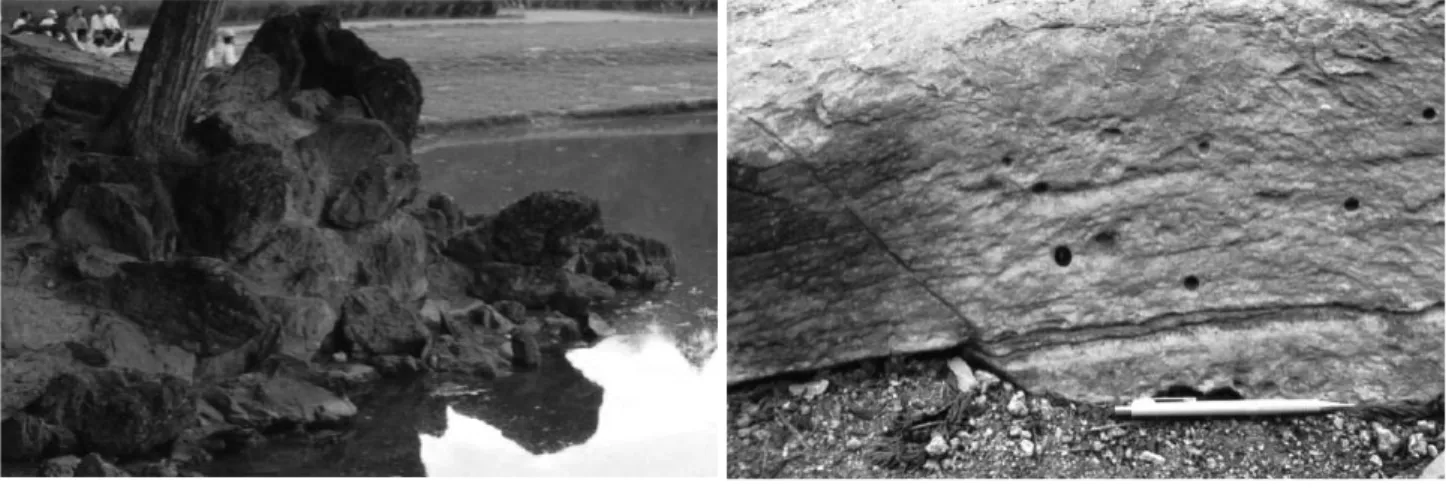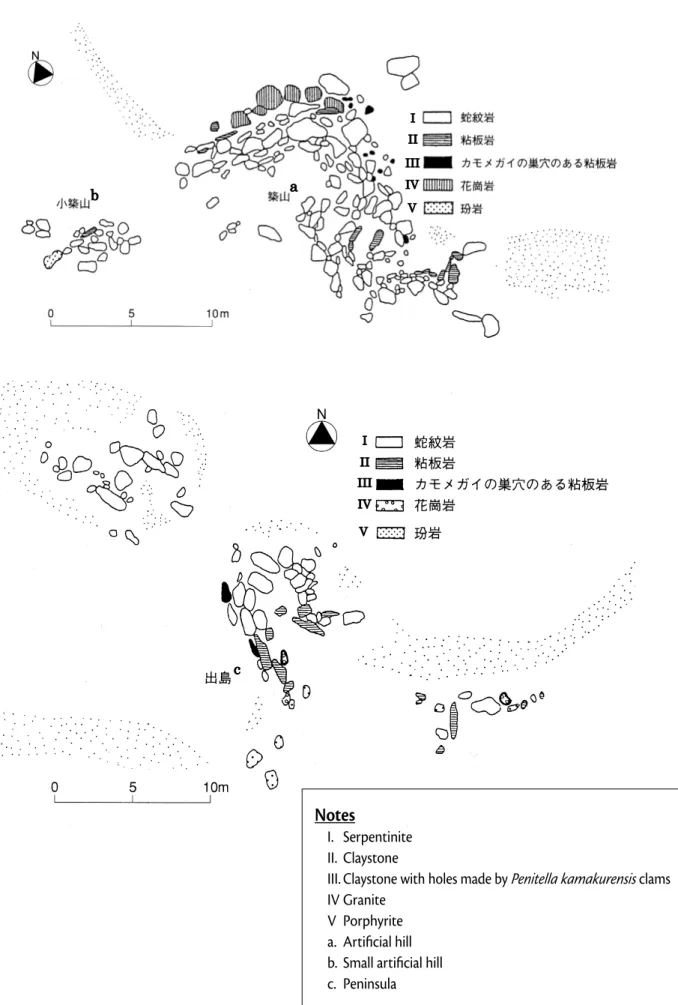96
AMASAKI Hiromasa
II
Motifs in Nature and Expressions of Japanese Gardens, and the Meaning and Form of Water
AMASAKI Hiromasa
Director, Research Center for Japanese Garden Art and Historical Heritage;
Professor, Kyôto University of Art and Design, JAPAN
1. Motifs in nature and expressions of Japanese Gardens
Japanese gardens have used nature as their motifs to varying degrees. As described in Sakuteiki (the book of gardening), this tendency was particularly remarkable in the Heian period. The spatial design from a waterfall or wellhead to a yarimizu stream and into a pond can be considered as an expression of “nature’s samsara” as symbolized by the
“transmigration of water.” Ponds which represented the ocean had islands; pebble beach techniques were used to represent the sandy beach landscape; the rough seashore was expressed with iwagumi rock arrangement. In particular, the pursuit of reality as seen in the garden at the Môtsû-ji Temple in Hiraizumi is startling.
Serpentinite and claystone are two major stone types used in the garden at the Môtsû-ji Temple. Given the fact that these stones are not available in the vicinity, it can be conjectured that the selection of these stones reflects the garden designer’s intention. Serpentinite, which is used as primarily an ornamental stone, was quarried from an area near Motai, about 10 km upstream along the Kitakamigawa River. It is believed that the dark yellow-green stone surface produced a solemn atmosphere (Fig. 3).
Attention should be paid to the claystone (Fig. 4) on the waterside of an artificial hill (Fig. 1) modeled on a rough seashore landscape. On the surface of the claystone, holes made by Penitella kamakurensis (rock-boring clams) (Fig. 2) were found, which revealed the fact that the claystone was quarried on the Sanriku Coast, which is the habitat of the clams. One can see the garden designer’s commitment to expressing the rough seashore in adamant pursuit of reality by carrying the claystone all the way from the shore of the
Sanriku Coast (the model of the landscape). The careful embodiment of nature in the construction phase can be regarded as a typical feature which graphically illustrates the idea behind garden building at the time — mimicking nature.
2. Meaning of water and form of ponds
Water has been linked with the image of a sacred, clean space, or has been recognized as a medium to indicate the sacredness of land. Given the possibility that water was considered a symbol of samsara or transmigration because of its nature as the origin of life, one would understand the role of water (ponds) as an important element for expressing the Pure Land world.
Meanwhile, Chinese gardens in early days were intended to embody the Shenxian world as a utopia where perennial youth and longevity were sought. For this reason, ponds which represented the ocean had islands of immortals.
Similarly, the Anaptch pond (a well-known ancient garden in South Korea) built in the Silla period was designed with the concept of paradise based on the cult of immortality. It is believed that three islands (representing Samsundo) were built in the pond which symbolized Donghae (the Sea of Japan).
Thus, ponds (representing utopia) were built in East Asian gardens. The question is, where did the form originate?
Existing Pure Land Amitabha murals in Dunhuang and other materials show rectangular ponds, which are “jeweled ponds” where Buddha show up in front of symmetrical towers. It is conjectured that these scenes were created under the influence of images of solemn and magnificent palaces in India and China in the process of expressing the Pure Land
97 The Studies For The Meeting II
world in the form of sutras or paintings. Imitating the living space of the rulers at the time was considered the most effective method from the viewpoint of representing utopia in the most paramount form imaginable and facilitating propagation.
Thus, it is a natural consequence that Pure Land gardens in Japan did not employ square ponds, and instead followed the format of shinden (aristocrats’ residence) style gardens featuring, for example, curved ponds which were designed to graphically express nature. It can be considered that the process of embodying ideas into landscapes took place while merging with local natural/cultural backgrounds in various forms ,while keeping a balance with worldly things.
3. Multilayered principles of space
As can be seen in the “Amida Coming over the Mountain”
scrolls, etc., natural mountains and gardens came to be visually combined in the midst of the growing popularity of Pure Land thought. The Muryôkô-in Hall (remains) in Hiraizumi is considered one typical example. Mt. Kinkeisan was seen at the end of the axis extended from the garden’s space arrangement. It has yet to be verified when the thought of a Pure Land in the mountains (which is considered by some experts to be related to “Amida descending to the world”) came into existence. It is reasonable to believe, however, that
fusion with nature worship (which was handed down from ancient times) lies at the root of this thought.
Japan’s ancient worship of nature developed into faith in huge rocks or big trees (as media of kami or deities), a concept of sacred mountains, and faith in Kumano Sanzan and other mountains as represented by Shugendô, which was derived from esoteric Buddhism. Such faith or concepts must have had a significant impact on Pure Land thought in combination with the Kami-Buddhist Amalgamation. This multilayered philosophy and religion can be considered to form the characteristics of Japanese culture.
On the other hand, Sakuteiki (the book of gardening), which was completed when Pure Land thought was gaining popularity, provides a hypothesis that the theory of Yin-Yang and the Five Elements can be observed in China’s ancient thought (and in the direction of streams in particular). The book also says that South Korean gardens in the Yi Dynasty period also had a tendency to have round islands and square ponds based on the theory of Yin-Yang and the Five Elements.
If this theory was interpreted as the theoretical embodiment of all things in the universe, one could argue that the essence of the ideal world lay in an awe and respect or yearning for nature as embodied in the form of gardens of any age or country, whether the expressions were concrete or abstract.
98
AMASAKI Hiromasa
II
Fig. 1 An artificial hill modeled on a rough seashore landscape
I II III
b
a
c d
e
g f
h
i
j
Notes
I. Motai metamorphic rock (crystalline schist) II. Serpentinite
III. Porphyrite
a. Motai b. HIRAIZUMI
c. Môtsû-ji temple garden d. Kanjizaiô-in temple garden e. Iwade
f. Kitakami Massif g. Kitakamigawa River
h. Ôya (claystone with holes on its surface) i. Sanriku Coast
j. Ishinomaki
(claystone with holes on its surface) Fig. 2 Holes made by Penitella kamakurensis clams observed on the claystone surface
Fig. 3 Quarries of major garden stones for the garden at Môtsû-ji Temple and the Kanjizaiô-in Hall garden Source : AMASAKI Hiromasa “Garden Stones and Origin of Water
— Stones and Water Streams of Japanese Gardens” (2002, Shôwadô)
99 The Studies For The Meeting II
Fig. 4 Garden at the Môtsû-ji Temple: Stone classification of the artificial hill’s stone arrangement (top) and peninsula’s stone arrangement (bottom)
Source : AMASAKI Hiromasa “Garden Stones and Origin of Water — Stones and Water Streams of Japanese Gardens” (2002, Shôwadô)
I II III IV V
b a
I II III IV V
c
Notes
I. Serpentinite II. Claystone
III. Claystone with holes made by Penitella kamakurensis clams IV Granite
V Porphyrite a. Artificial hill b. Small artificial hill c. Peninsula

